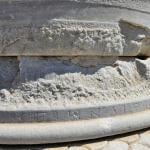[German archaeologist Klaus] Schmidt has uncovered a vast and beautiful temple complex, a structure so ancient that it may be the very first thing human beings ever built. The site isn’t just old, it redefines old: the temple was built 11,500 years ago—a staggering 7,000 years before the Great Pyramid, and more than 6,000 years before Stonehenge first took shape. The ruins are so early that they predate villages, pottery, domesticated animals, and even agriculture—the first embers of civilization. In fact, Schmidt thinks the temple itself, built after the end of the last Ice Age by hunter-gatherers, became that ember—the spark that launched mankind toward farming, urban life, and all that followed.
Göbekli Tepe—the name in Turkish for “potbelly hill”—lays art and religion squarely at the start of that journey. After a dozen years of patient work, Schmidt has uncovered what he thinks is definitive proof that a huge ceremonial site flourished here, a “Rome of the Ice Age,” as he puts it, where hunter-gatherers met to build a complex religious community. Across the hill, he has found carved and polished circles of stone, with terrazzo flooring and double benches. All the circles feature massive T-shaped pillars that evoke the monoliths of Easter Island.
Though not as large as Stonehenge—the biggest circle is 30 yards across, the tallest pillars 17 feet high—the ruins are astonishing in number. Last year Schmidt found his third and fourth examples of the temples. Ground-penetrating radar indicates that another 15 to 20 such monumental ruins lie under the surface. Schmidt’s German-Turkish team has also uncovered some 50 of the huge pillars, including two found in his most recent dig season that are not just the biggest yet, but, according to carbon dating, are the oldest monumental artworks in the world.
The new discoveries are finally beginning to reshape the slow-moving consensus of archeology. Göbekli Tepe is “unbelievably big and amazing, at a ridiculously early date,” according to Ian Hodder, director of Stanford’s archeology program. Enthusing over the “huge great stones and fantastic, highly refined art” at Göbekli, Hodder—who has spent decades on rival Neolithic sites—says: “Many people think that it changes everything…It overturns the whole apple cart. All our theories were wrong.”
Schmidt’s thesis is simple and bold: it was the urge to worship that brought mankind together in the very first urban conglomerations. The need to build and maintain this temple, he says, drove the builders to seek stable food sources, like grains and animals that could be domesticated, and then to settle down to guard their new way of life. The temple begat the city.
This theory reverses a standard chronology of human origins, in which primitive man went through a “Neolithic revolution” 10,000 to 12,000 years ago. In the old model, shepherds and farmers appeared first, and then created pottery, villages, cities, specialized labor, kings, writing, art, and—somewhere on the way to the airplane—organized religion. As far back as Jean-Jacques Rousseau, thinkers have argued that the social compact of cities came first, and only then the “high” religions with their great temples, a paradigm still taught in American high schools.
Religion now appears so early in civilized life—earlier than civilized life, if Schmidt is correct—that some think it may be less a product of culture than a cause of it. . . .
Genetic mapping shows that the first domestication of wheat was in this immediate area—perhaps at a mountain visible in the distance—a few centuries after Göbekli’s founding. Animal husbandry also began near here—the first domesticated pigs came from the surrounding area in about 8000 B.C., and cattle were domesticated in Turkey before 6500 B.C. Pottery followed.
via Turkey: Archeological Dig Reshaping Human History – Newsweek.com.
HT: Joe Carter














